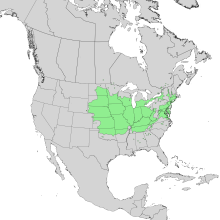Celtis occidentalis
| Common hackberry | |
|---|---|
 |
|
| A mature tree in winter in Kentucky | |
| Scientific classification | |
| Kingdom: | Plantae |
| (unranked): | Angiosperms |
| (unranked): | Eudicots |
| (unranked): | Rosids |
| Order: | Rosales |
| Family: | Cannabaceae |
| Genus: | Celtis |
| Species: | C. occidentalis |
| Binomial name | |
|
Celtis occidentalis L. |
|
 |
|
| Native range | |
 |
|
| Closeup of native range | |
Celtis occidentalis, commonly known as the common hackberry, is a large deciduous tree native to North America. It is also known as the nettletree, sugarberry, beaverwood, northern hackberry, and American hackberry. It is a moderately long-livedhardwood with a light-colored wood, yellowish gray to light brown with yellow streaks.
The common hackberry is easily distinguished from elms and some other hackberries by its cork-like bark with wart-like protuberances. The remarkable bark pattern is even more pronounced in younger trees, with the irregularly-spaced ridges resembling long geologic palisades of sedimentary [layered] rock formations when viewed edge-wise [cross-section]. Coins as large as USA quarters can easily be laid flat against the valleys, which may be as deep as an adult human finger.
The leaves are distinctly asymmetrical and coarse-textured. It produces small fruits that turn orange-red to dark purple in the autumn, often staying on the trees for several months. The common hackberry is easily confused with the sugarberry (Celtis laevigata) and is most easily distinguished by range and habitat. The common hackberry also has wider leaves that are coarser above than the sugarberry.
The common hackberry is a medium-sized tree, 9 to 15 metres (30 to 50 ft) in height, with a slender trunk. In the best conditions in the southern Mississippi Valley area, it can grow to 40 metres (130 ft). It has a handsome round-topped head and pendulous branches. It prefers rich moist soil, but will grow on gravelly or rocky hillsides. The roots are fibrous and it grows rapidly. In the western part of its range, trees may still grow up to 29 m (95 ft). The maximum age attained by hackberry is probably between 150 and 200 years in ideal conditions.
The bark is light brown or silvery gray, broken on the surface into thick appressed scales and sometimes roughened with excrescences; the pattern is very distinctive.
The bark of the same tree on the campus of the University of Chicago
The ridges on the bark of a tree at the Jevremovac Botanical Garden in Serbia
Closeup of the ridges on the bark of a street tree in Serbia
...
Wikipedia
